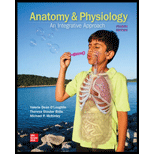
Introduction:
Atoms are the smallest particles that exhibit some chemical properties and consist of protons, neutrons, and electrons. The protons and neutrons are present in the nucleus and electrons keep revolving around the nucleus in an orbit.
Answer to Problem 1DYKB
Correct answer:
The isotopes have a different number of neutrons. Therefore, option c. is correct.
Explanation of Solution
Reason for the correct statement:
Option c. is given as “isotopes”. The isotopes are the different atoms of the same element that have the same number of protons and electrons but differ in the number of neutrons and atomic masses.
Hence, option c. is correct.
Reasons for incorrect statements:
Option a. is given as “isomers”. The isomers have same atomic masses and it is a molecule that has a same molecular formula but differs in the arrangement of atoms. Hence, option a. is incorrect.
Option b. is given as “ions”. Ions are charged atom and do not have an equal number of electrons and protons. Hence, option b. is incorrect.
Option d. is given as “organic atoms”. These are the atoms like carbon, oxygen, nitrogen, hydrogen, and phosphorus. These atoms form organic molecules. The protons, neutrons, and electrons are the same as an ordinary atom. Hence, option d. is incorrect.
Hence, options a., b., and d. are incorrect.
The isotopes are the atoms that have different atomic masses due to the difference in neutrons and have similar electrons and protons.
Want to see more full solutions like this?
Chapter 2 Solutions
ANATOMY+PHYSIOLOGY-CONNECT ACCESS
- In one paragraph show how atoms and they're structure are related to the structure of dna and proteins. Talk about what atoms are. what they're made of, why chemical bonding is important to DNA?arrow_forwardWhat are the structure and properties of atoms and chemical bonds (especially how they relate to DNA and proteins).arrow_forwardThe Sentinel Cell: Nature’s Answer to Cancer?arrow_forward
- Molecular Biology Question You are working to characterize a novel protein in mice. Analysis shows that high levels of the primary transcript that codes for this protein are found in tissue from the brain, muscle, liver, and pancreas. However, an antibody that recognizes the C-terminal portion of the protein indicates that the protein is present in brain, muscle, and liver, but not in the pancreas. What is the most likely explanation for this result?arrow_forwardMolecular Biology Explain/discuss how “slow stop” and “quick/fast stop” mutants wereused to identify different protein involved in DNA replication in E. coli.arrow_forwardMolecular Biology Question A gene that codes for a protein was removed from a eukaryotic cell and inserted into a prokaryotic cell. Although the gene was successfully transcribed and translated, it produced a different protein than it produced in the eukaryotic cell. What is the most likely explanation?arrow_forward
- Molecular Biology LIST three characteristics of origins of replicationarrow_forwardMolecular Biology Question Please help. Thank you For E coli DNA polymerase III, give the structure and function of the b-clamp sub-complex. Describe how the structure of this sub-complex is important for it’s function.arrow_forwardMolecular Biology LIST three characteristics of DNA Polymerasesarrow_forward
 Concepts of BiologyBiologyISBN:9781938168116Author:Samantha Fowler, Rebecca Roush, James WisePublisher:OpenStax College
Concepts of BiologyBiologyISBN:9781938168116Author:Samantha Fowler, Rebecca Roush, James WisePublisher:OpenStax College Principles Of Radiographic Imaging: An Art And A ...Health & NutritionISBN:9781337711067Author:Richard R. Carlton, Arlene M. Adler, Vesna BalacPublisher:Cengage Learning
Principles Of Radiographic Imaging: An Art And A ...Health & NutritionISBN:9781337711067Author:Richard R. Carlton, Arlene M. Adler, Vesna BalacPublisher:Cengage Learning Human Biology (MindTap Course List)BiologyISBN:9781305112100Author:Cecie Starr, Beverly McMillanPublisher:Cengage Learning
Human Biology (MindTap Course List)BiologyISBN:9781305112100Author:Cecie Starr, Beverly McMillanPublisher:Cengage Learning
 Biology (MindTap Course List)BiologyISBN:9781337392938Author:Eldra Solomon, Charles Martin, Diana W. Martin, Linda R. BergPublisher:Cengage Learning
Biology (MindTap Course List)BiologyISBN:9781337392938Author:Eldra Solomon, Charles Martin, Diana W. Martin, Linda R. BergPublisher:Cengage Learning





